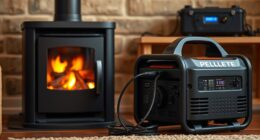As an enthusiastic wood stove aficionado, I’ve mastered the art of igniting a fire that warms the space and soothes the soul. Let me share my dependable technique with you.
In this guide, I’ll walk you through the steps to effortlessly ignite your wood stove, creating a cozy ambiance in your home.
From gathering the necessary materials to maintaining a safe and efficient fire, I’ve got you covered.
Get ready to embrace the crackling warmth and inviting glow of your wood stove.

Key Takeaways
- Common mistakes in lighting a wood stove include using too much paper or kindling, which leads to a smoky fire.
- Insufficient air circulation results in a slow burn, so opening air intake vents and ash pan door is necessary for proper airflow.
- Gathering dry and seasoned firewood is important for successful wood stove lighting.
- Using kindling such as small twigs or newspaper to ignite the fire and adding small logs gradually helps build a fire efficiently.
Understanding the Basics of Wood Stove Lighting
I need to learn the basics of wood stove lighting so that I can effectively heat my home during the winter.
When it comes to lighting a wood stove, there are common mistakes that people often make.
One of these mistakes is using too much paper or kindling, which can lead to a smoky fire that’s difficult to control.
Another mistake isn’t allowing enough air circulation, which can result in a slow and inefficient burn.

To properly light a wood stove, it’s important to use the right type of wood. Hardwoods such as oak or maple are ideal for optimal stove lighting. They burn longer and produce more heat compared to softwoods like pine.
Gathering the Necessary Materials
After gathering the necessary materials, I’ll be able to properly light my wood stove and enjoy a warm and cozy winter in my home.
Building a fire in a wood stove requires a few key elements to ensure proper ventilation and efficient burning. Firstly, I gather dry and seasoned firewood, as damp wood can create excess smoke and reduce heat output.
Next, I ensure proper airflow by opening the air intake vents and ash pan door. This allows oxygen to flow into the stove, aiding combustion.

To ignite the fire, I use kindling, such as small twigs or newspaper, placed in the center of the stove. Once the kindling is lit, I add small logs gradually, allowing the fire to build.
Preparing the Firebox for a Successful Burn
Opening the air intake vents and cleaning out the ash pan are essential steps in preparing the firebox for a successful burn. As someone who’s been using a wood stove for many years, I understand the importance of proper maintenance and preparation. Here are three key things to consider when preparing your firebox:
Firewood storage: Make sure your firewood is properly seasoned and stored in a dry area. This will ensure that the wood burns efficiently and produces less smoke.
Cleaning the wood stove: Regularly clean out the ash pan to remove any buildup of ash and debris. This will allow for better airflow and prevent blockages that could hinder the burn.

Check the air intake vents: Before starting a fire, ensure that the air intake vents are fully open. This will provide the necessary oxygen for a strong and steady burn.
Lighting the Fire: Step-by-Step Instructions
To effectively light the fire, carefully place a small stack of kindling in the center of the firebox, and then gently ignite it with a match or lighter. Firewood selection is crucial for a successful wood stove fire. It is important to use seasoned firewood that has been dried for at least six months to ensure optimal burning and minimal smoke. Softwoods like pine and fir are ideal for starting a fire, while hardwoods such as oak and maple provide longer-lasting heat. Troubleshooting common issues, such as difficulty in lighting the fire or excessive smoke, can be resolved by checking for proper airflow, adjusting the damper, and ensuring the firewood is dry. Remember, a well-lit fire is the foundation for maintaining a safe and efficient wood stove fire.
| Firewood Selection | Troubleshooting Common Issues |
|---|---|
| Use seasoned firewood | Check for proper airflow |
| Softwoods for starting the fire | Adjust the damper |
| Hardwoods for longer-lasting heat | Ensure firewood is dry |
Now that we have successfully lit the fire, let’s discuss how to maintain a safe and efficient wood stove fire.
Can Using a Cat to Stone Help with Lighting a Wood Stove?
When it comes to wood stove and cat safety, using a cat to light a fire is not recommended. It can be dangerous for the cat and the stove. Instead, use proper fire-starting materials to ensure a safe and efficient way to light your wood stove.
Maintaining a Safe and Efficient Wood Stove Fire
I carefully tend to the wood stove fire, ensuring it stays safe and efficient throughout the evening. Fire safety and wood stove maintenance are crucial for a smooth and worry-free experience. Here are three essential tips to keep in mind:

Regular Cleaning: Regularly clean your wood stove to remove any debris, ashes, or creosote buildup. This not only improves efficiency but also reduces the risk of chimney fires.
Proper Ventilation: Ensure that your wood stove has proper ventilation to prevent the buildup of harmful gases, such as carbon monoxide. Regularly check the chimney flue and damper to ensure they’re clear and functioning correctly.
Safe Fuel Usage: Only burn seasoned hardwood in your wood stove. Avoid using wet or green wood, as it produces more smoke, increases creosote buildup, and reduces efficiency.
Frequently Asked Questions
How Often Should I Clean the Chimney of My Wood Stove?
I clean my wood stove chimney about once a year to ensure proper ventilation and prevent buildup of creosote. Regular cleaning frequency depends on usage and type of wood burned. Chimney maintenance is crucial for safe operation.

Can I Use Any Type of Wood to Light My Wood Stove?
I’ve found that using dry hardwood like oak or maple works best for lighting my wood stove. It burns longer and produces more heat. Remember to follow safety guidelines when lighting your stove.
Are There Any Specific Safety Precautions I Should Take When Lighting a Wood Stove?
Fire safety measures are crucial when lighting a wood stove. It’s important to have necessary equipment like heat-resistant gloves and a fire extinguisher nearby. Taking these precautions ensures a safe and controlled fire-starting process.
How Long Does It Typically Take for a Wood Stove to Heat up a Room?
On average, it takes a wood stove about 20-30 minutes to heat up a room. However, this can vary depending on factors like the size of the room, insulation, and the type of wood used.
Can I Leave My Wood Stove Unattended While It Is Burning?
I wouldn’t recommend leaving a burning wood stove unattended. It’s important to prioritize safety when lighting a wood stove. Always follow proper precautions and never leave it alone to avoid any potential accidents or hazards.

Conclusion
As the flame dances and the warmth envelops the room, the wood stove becomes more than just a source of heat. It symbolizes the connection to nature, the simplicity of life, and the comfort of a cozy home.
Lighting a wood stove isn’t just a task, but an art that requires understanding, preparation, and care. By following the steps and maintaining safety, you can create a safe and efficient fire that won’t only warm your space but also ignite a sense of peace and tranquility within you.
Growing up surrounded by the vast beauty of nature, Sierra was always drawn to the call of the wild. While others sought the comfort of the familiar, she ventured out, embracing the unpredictable and finding stories in the heartbeat of nature.
At the epicenter of every remarkable venture lies a dynamic team—a fusion of diverse talents, visions, and passions. The essence of Best Small Wood Stoves is crafted and refined by such a trio: Sierra, Logan, and Terra. Their collective expertise has transformed the platform into a leading authority on small wood stoves, radiating warmth and knowledge in equal measure.











